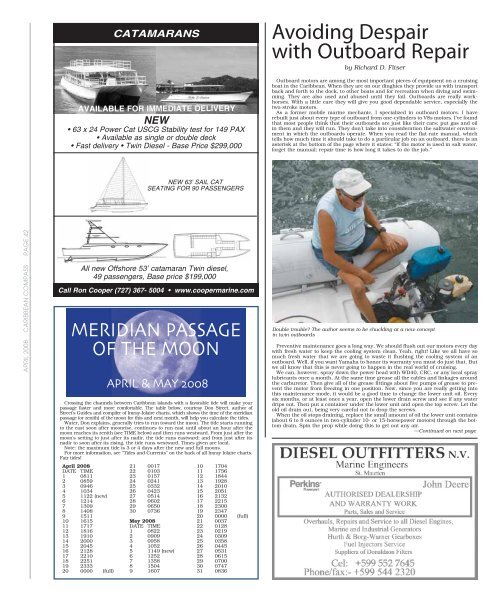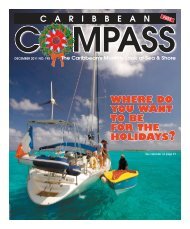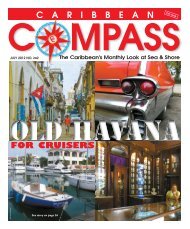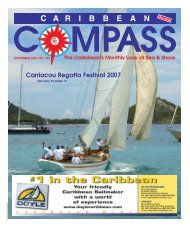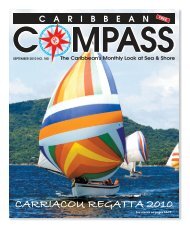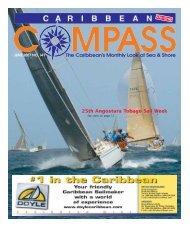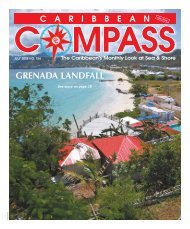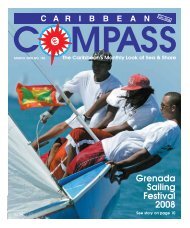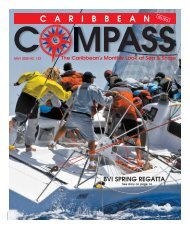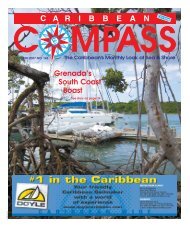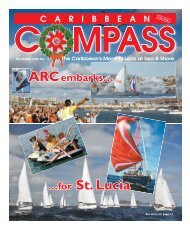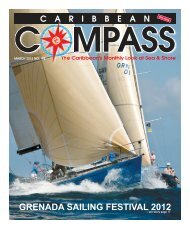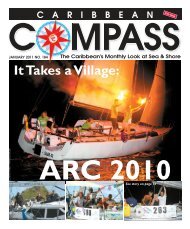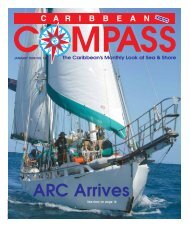Bequia Easter Regatta 2008 - Caribbean Compass
Bequia Easter Regatta 2008 - Caribbean Compass
Bequia Easter Regatta 2008 - Caribbean Compass
Create successful ePaper yourself
Turn your PDF publications into a flip-book with our unique Google optimized e-Paper software.
APRIL <strong>2008</strong> CARIBBEAN COMPASS PAGE 42<br />
MERIDIAN PASSAGE<br />
OF THE MOON<br />
APRIL & MAY <strong>2008</strong><br />
Crossing the channels between <strong>Caribbean</strong> islands with a favorable tide will make your<br />
passage faster and more comfortable. The table below, courtesy Don Street, author of<br />
Street’s Guides and compiler of Imray-Iolaire charts, which shows the time of the meridian<br />
passage (or zenith) of the moon for this and next month, will help you calculate the tides.<br />
Water, Don explains, generally tries to run toward the moon. The tide starts running<br />
to the east soon after moonrise, continues to run east until about an hour after the<br />
moon reaches its zenith (see TIME below) and then runs westward. From just after the<br />
moon’s setting to just after its nadir, the tide runs eastward; and from just after its<br />
nadir to soon after its rising, the tide runs westward. Times given are local.<br />
Note: the maximum tide is 3 or 4 days after the new and full moons.<br />
For more information, see “Tides and Currents” on the back of all Imray Iolaire charts.<br />
Fair tides!<br />
April <strong>2008</strong><br />
DATE TIME<br />
1 0811<br />
2 0859<br />
3 0946<br />
4 1034<br />
5 1122 (new)<br />
6 1214<br />
7 1309<br />
8 1408<br />
9 1511<br />
10 1615<br />
11 1717<br />
12 1816<br />
13 1910<br />
14 2000<br />
15 2045<br />
16 2128<br />
17 2210<br />
18 2251<br />
19 2333<br />
20 0000 (full)<br />
CATAMARANS<br />
AVAILABLE FOR IMMEDIATE DELIVERY<br />
NEW<br />
• 63 x 24 Power Cat USCG Stability test for 149 PAX<br />
• Available as single or double deck<br />
• Fast delivery • Twin Diesel - Base Price $299,000<br />
NEW 63’ SAIL CAT<br />
SEATING FOR 90 PASSENGERS<br />
All new Offshore 53’ catamaran Twin diesel,<br />
49 passengers, Base price $199,000<br />
Call Ron Cooper (727) 367- 5004 • www.coopermarine.com<br />
21 0017<br />
22 0103<br />
23 0157<br />
24 0241<br />
25 0332<br />
26 0423<br />
27 0514<br />
28 0602<br />
29 0650<br />
30 0736<br />
May <strong>2008</strong><br />
DATE TIME<br />
1 0822<br />
2 0909<br />
3 0958<br />
4 1052<br />
5 1149 (new)<br />
6 1252<br />
7 1358<br />
8 1504<br />
9 1607<br />
10 1704<br />
11 1756<br />
12 1844<br />
13 1928<br />
14 2010<br />
15 2051<br />
16 2132<br />
17 2215<br />
18 2300<br />
19 2347<br />
20 0000 (full)<br />
21 0037<br />
22 0128<br />
23 0219<br />
24 0309<br />
25 0358<br />
26 0445<br />
27 0531<br />
28 0615<br />
29 0700<br />
30 0747<br />
31 0836<br />
Avoiding Despair<br />
with Outboard Repair<br />
by Richard D. Fitser<br />
Outboard motors are among the most important pieces of equipment on a cruising<br />
boat in the <strong>Caribbean</strong>. When they are on our dinghies they provide us with transport<br />
back and forth to the dock, to other boats and for recreation when diving and swimming.<br />
They are also used and abused until they fail. Outboards are really workhorses.<br />
With a little care they will give you good dependable service, especially the<br />
two-stroke motors.<br />
As a former mobile marine mechanic, I specialized in outboard motors. I have<br />
rebuilt just about every type of outboard from one-cylinders to V8s motors. I’ve found<br />
that most people think that their outboards are just like their cars: put gas and oil<br />
in them and they will run. They don’t take into consideration the saltwater environment<br />
in which the outboards operate. When you read the flat-rate manual, which<br />
tells how much time it should take to do a particular job on an outboard, there is an<br />
asterisk at the bottom of the page where it states: “If the motor is used in salt water,<br />
forget the manual; repair time is how long it takes to do the job.”<br />
Double trouble? The author seems to be chuckling at a new concept<br />
in twin outboards<br />
Preventive maintenance goes a long way. We should flush out our motors every day<br />
with fresh water to keep the cooling system clean. Yeah, right! Like we all have so<br />
much fresh water that we are going to waste it flushing the cooling system of an<br />
outboard. Well, if you want Yamaha to honor its warranty you must do just that. But<br />
we all know that this is never going to happen in the real world of cruising.<br />
We can, however, spray down the power head with WD40, CRC, or any local spray<br />
lubricants once a month. At the same time grease all the cables and linkages around<br />
the carburetor. Then give all of the grease fittings about five pumps of grease to prevent<br />
the motor from freezing in one position. Now, since you are really getting into<br />
this maintenance mode, it would be a good time to change the lower unit oil. Every<br />
six months, or at least once a year, open the lower drain screw and see if any water<br />
drips out. Then put a container under the lower unit and open the top screw. Let the<br />
old oil drain out, being very careful not to drop the screws.<br />
When the oil stops draining, replace the small amount of oil the lower unit contains<br />
(about 6 to 8 ounces in two-cylinder 10- or 15-horsepower motors) through the bottom<br />
drain. Spin the prop while doing this to get out any air.<br />
—Continued on next page


